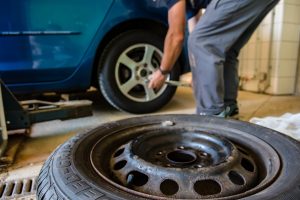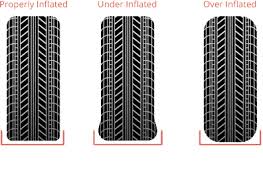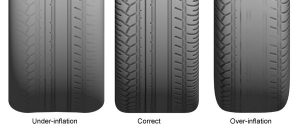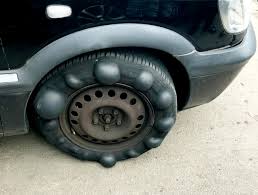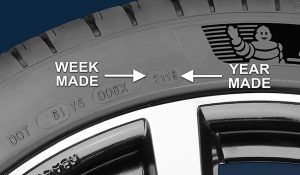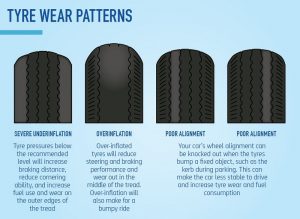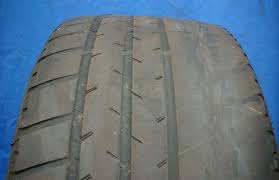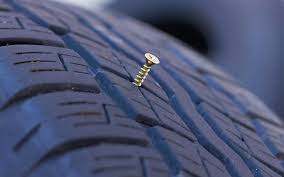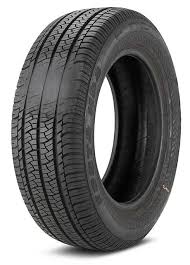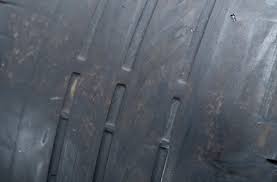Common Tyre Problems
Page Contents
The Most Common Tyre Problems on Cars & Vans will be experienced by all motorists at some point. Whether its a puncture, worn tyres, or misalignment, we have put together this guide to help you understand the potential problems that can be caused by tyres. Enabling you spot them before they become dangerous or significantly decrease the life of your tyres.
Your tyres are your only point of contact with the road so spotting the signs of potentially dangerous issues can help keep you and other motorists safe. It may even help you identify issues before they cause further damage to other safety critical vehicle components.
Over inflation
Tyres that have too much pressure in them will not perform as the manufacturer intended. Once the tyre has too much air or nitrogen in them it causes the central tread of the tyre to be more pronounced. Resulting in the tyre running on the central part of the tyre only. The outer edges of the tread on both sides of the tyre will fail to make contact with the road surface. This will reduce the amount of tyre making contact with the road surface.
A number of issues will arise from this. The tyre will have less contact with the road surface and it will also have less tread on the surface of the road resulting in the tyre tread being able to disperse less water in wet conditions. It will also cause the tyre to wear out prematurely as the central tread on the tyre will wear out quicker than the outer tread of the tyre.
Over inflated Tyres will cause you to have to replace your tyres prematurely.
You can tell if you have an over inflated tyre by looking at your tyres’ wear patterns. Are the centres of your tyres particularly worn down in comparison to the rest of the tyre? If so, they probably need some air letting out. Call in to either Darlington Tyre & Auto Care or Teesdale (Stockton) Tyre & Auto Care.
Under inflation
Under inflation is an extremely common tyre problem. 60% of passenger cars in Europe are driving around with lower tyre pressures than recommended. Road safety organisations, tyre manufacturers and industry media are conducting various campaigns to improve drivers’ awareness. Drivers and operators do not check them as often as they should.
Few people are aware that correct tyre pressure have an impact on many aspects of our comfort and safety. Unfortunately, the reasons for this are driver negligence. Having too little pressure in your tyres will result in:
- extended braking distance on wet roads by several metres (width of two pedestrian crossings),
- reduced aquaplaning resistance of the tyres,
- delayed and less precise reactions of the car,
- risk of over- or understeering of the vehicle,
- more difficult parking manoeuvres (especially in cars without power steering),
- a higher chance of the tyre blowing out as the sidewall becomes damaged,
- increased risk of punctures or other tyre damage as more of the tyre makes contact with the road surface
- faster wear of steering components.
How Do I Know What pressure To Put In My Tyres
Manufacturers tyre pressures must be adjusted to suit the vehicles load and weight. Most vehicle manufacturers list the tyres pressures required in the drivers handbook. Or in the drivers inner door frame of petrol flap. If you are unsure then please do not hesitate to contact us as at the Auto Care Group as we have access to all manufactures tyre pressure requirements.
Bulging Tyre Problem
Bulges in a tyre are usually as a result of impact damage. Hitting a pothole, curb, or debris on the road can lead to damage of the tyres inner structure. Tyre sidewalls are built to withstand some pretty harsh treatment but if the inner structure of the tyre becomes damaged it can result in a bulge. Driving up kerbs to park, for example, can result in irreversible tyre damage and will require the tyre to be replaced. Tyre sidewall damage cannot be repaired
Under-inflation and over-inflation will also put tyres at a greater risk of damage from impacts.
Cracking Tyre Rubber
The rubber on the outside of the tyre is made up of lots of polymers that are knitted together to form molecules. Tyre cracking is caused by these bonds breaking down. Causes for this can be:
UV Rays/Extreme Heat
The polymers in the tyre can expand in the heat and constrict in the cold. This constant movement can weaken the bonds over time, which is when cracks begin to appear. UV rays can also have the same effect. UV rays are one of the biggest causes of cracked tyres, but it’s nearly impossible for most people to keep their car in a garage or parked in the shade all the time.
Age
As your tyres get older, the polymers naturally weaken and begin to break down. This causes your tyres to harden and become brittle – and this loss of elasticity can mean the tyres crack. Even if your car hasn’t been driven for a few years and is stored in a garage, the tyres can still weaken and crack.
It’s actually more beneficial to drive your car every now and then instead of leaving it parked. The chemical that prevents the tyre from drying out and cracking is released when the tyre is moving. Therefore, if the car is parked for a long time, this chemical won’t be able to work efficiently.
Water
Rubber is mainly waterproof. However water can still permeate the tyre after driving on wet roads for a prolonged period of time.
Degradation
Tyres are made of rubber, which is an organic material that’s taken from trees. This makes them biodegradable and no amount of chemicals will stop your tyres from naturally degrading over time.
Certain chemicals and compounds are applied when your tyres are made to reinforce them and slow down degradation, however these won’t work forever.
Tyre pressure
As already covered one of the most common tyre issues is inflation. Over or under pressurised tyres can become cracked. With under pressurised tyres, more heat is created when you’re driving. This is because more of the surface of an underinflated tyre is in contact with the road, which creates more friction. Over pressurised tyres can add extra stress to the tyre wall and cause bulging.
Incorrect Tyre pressures will cause a decrease in fuel economy.
Cracked or bulging tyres should not be repaired and instead the tyre should always be replaced. The Auto Care Group with their sites at Darlington & Stockton carry a large supply of all tyre brands in stock to cater for this eventuality.
Misalignment (Tracking)
Another of the most common tyre problems is Misalignment. It’s not always easy to detect if a car’s wheels are misaligned, especially as this can occur gradually over a prolonged period of time. However, some of the key signs that the car’s wheels are misaligned are as follows:
- Uneven tyre wear on the fronts or the rears – tyres suffering from misalignment often show signs of excessive wear on either the inside or outside edges. It is not always easy to visibly see the tyre wear. However, by carefully running your hands over the tyre it is possible to detect if the rubber has worn unevenly or excessively. This should be done with extreme caution as fine wires from the tyre carcass may protrude from the rubber.
- The car pulls to one side – When driving a misaligned car along a straight flat road, you may find that you need to compensate through the steering wheel to keep the car driving straight as the car drifts to one side.
- A crooked steering wheel – Even when the car is driving straight ahead the steering wheel is not straight or level.
The Auto Care Group in Darlington & Stockton are both equipped with John Bean Visualisers by Snap ON. These are some of the most advanced wheel alignment systems on the market today. We can adjust all 4 wheels (where the vehicle allows) on all makes and models and have the manufacturers settings for all vehicles.
Punctured Tyres
Punctured tyres usually happen as the result of a piece of road debris, for example a nail or screw, pushing through the tyre and penetrating into sealed air chamber. This will result in a loss of pressure from within the inside of the tyre. Almost 80% of punctures occur in the rear tyres. Your front tyres flick them up into the air and while bouncing/spinning the rear tyres catch them on the point and they pierce the tyre.
Unfortunately foreign objects and road debris can be found on most road surfaces. It is almost impossible to see these items especially when driving at speed. Therefore you will experience a puncture or cut in your tyre at some point.
This sort of damage is rarely the fault of the driver.
Other forms of ‘puncture’ which are not necessarily tyre related are:
Leaking valve – When having tyres fitted you should always have a new valve, as a rubber valve deteriorates with age ad will in the end start to leak.
Corrosion – This is where water has got under the paint of the wheel rim and slowly corrodes the steel /aluminium causing the paint to lift. This then allows air to escape.
Split or Cracked Wheel Rim – Occasionally after hitting a kerb or pothole an alloy wheel can split, allowing the air out.
Old tyres – As rubber deteriorates with age the rubber hardens and it loses its the seal against the wheel rim or age related cracks appear in the tread or sidewall.
Flat Spot
Flat Spots are where a tyre has a particular section of the tread that has been worn flat. The most common reason for this emergency barking or applying the handbrake whilst the car is in motion. This can lead to almost instant tyre wear in a very specific area. As the tyre stops rotating, causing excessive friction and tyre wear on the part of the tread rubbing against the ground. However vehicles fitted with Anti locking braking systems (ABS) don’t have this problem. ABS braking system ensures the wheels don’t ‘lock’ in place.
However brakes can still become locked for various other braking issues, such as a faulty brake caliper, and if driven flat spots will occur
Tyre Wear and Tear
Wear and tear is the phrase used to describe your normal day to day use of the tyre. As with all products general wear and tear will result in the tyre wearing down normally over its lifetime and eventually wearing out.
You must regularly check your tyres to ensure that the tread is kept over 1.6mm in order to ensure it is within the legal limit. If the tread depth is below 1.6mm, you cannot legally drive on the roads and must have your tyres replaced. It is worth noting, however, that this level of wear is the absolute minimum. Replacing your tyres before they reach this level will ensure your tyres are safe to be driven on the roads without sacrificing performance and grip.
It has long been known that a decrease in tyre tread depth can lead to the deterioration of a tyre’s performance. This is mainly during cornering, and straight line braking in the wet. A tyre is unable to deal with the same volume of water on the road at lower tread depths. This means that the tyre is unable to transmit traction and braking forces as effectively. Stopping distances start to increase dramatically at tread depths of below 3mm.
At the legal minimum tread depth of 1.6mm, the stopping distance is increased by 36.8% on the hot rolled asphalt and 44.6% on the smooth concrete.
As a result the Auto Care Group would always recommend changing your tyres at 3mm
Auto Care Group
If you think your tyres are in need of replacement, it’s important that your new tyres are fitted correctly and safely. The Auto Care Group based in Darlington & Stockton specialise in tyre fitting on all makes and models, ensuring your vehicle is safe for road use.
We also carry out free tyre checks and 4 Wheel alignment.
The Auto Care Group based in Darlington & Stockton cater for all your automotive needs and are experts in resolving your tyre problems. We also carry out car servicing on all make and models. Including on cars and vans under 3 years old without invalidating your manufacturers warranty. MOT Testing, Clutches, Exhausts, Wheel Alignment, Engine Diagnostics, Brakes & all types of repairs.
Darlington Tyre & Auto Care 01325 488855

Teesdale Tyre & Auto Care 01642 676667






